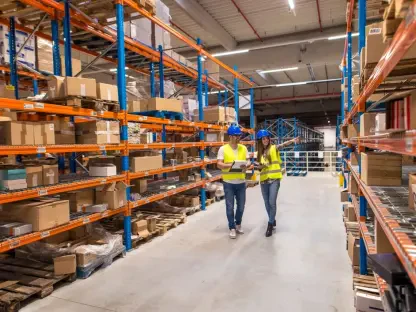In an era marked by tumultuous trade policies and shifting economic landscapes, Procter & Gamble (P&G) finds itself navigating the complex terrain shaped by tariffs. The imposition of tariffs by the U.S. administration in recent years has challenged many multinational corporations, prompting them to reconsider their supply chain strategies. P&G, a leading consumer goods company, has opted for a cautious approach in response to these tariff-induced uncertainties. Unlike some of its competitors making swift changes to circumvent tariff impacts, P&G has chosen a strategy that focuses on waiting until there is a clearer understanding of the economic environment before making significant supply chain adjustments. This calculated prudence highlights the strategic challenges faced by global corporations amid the political and economic shifts influencing their business operations.
Strategic Adaptation to Tariff Uncertainty
Tariffs have introduced a layer of unpredictability, forcing many companies to rethink their sourcing and production models. For P&G, this has meant a deliberate pause before committing to any substantial alterations in its supply chain. The company’s CFO, Andre Schulten, emphasizes the risk of hasty decisions that might require costly reversals later. This stance is informed by the extensive time and resources required to modify supply chain operations significantly. P&G’s strategy reflects a broader understanding of the volatility inherent in the global trade environment, highlighting the need for careful planning and foresight.
While some industry giants like Pfizer and Eli Lilly have ramped up domestic manufacturing to sidestep tariffs, P&G’s response underscores a different approach that values stability and long-term planning over immediate reactions. The decision to wait and see is rooted in the belief that enduring economic changes necessitate a more measured response. For P&G, making premature adjustments could not only incur high costs but also disrupt the intricate logistics that underpin its vast product offerings. This approach reveals an appreciation for the complexity of modern supply chains, where changes must be assessed for their long-ranging impacts before implementation.
Diverse Approaches Among Multinational Corporations
P&G’s strategy stands in contrast to various multinationals that have aggressively restructured their supply chains in direct response to tariffs. Colgate-Palmolive, for example, has taken clear steps to diversify its supply networks, thereby lowering its reliance on Chinese imports—a common target of U.S. tariffs. This difference in strategic choices highlights the varied approaches corporations are taking to handle tariff-related challenges. Some companies are pursuing immediate, tangible actions to minimize tariff repercussions, reflecting diverse perspectives on how best to safeguard operations in an unpredictable global trade climate.
As regionalization becomes an emerging trend, many U.S. companies have redirected production closer to their key markets to mitigate risks associated with geopolitical fluctuations. P&G, having anticipated these shifts, has invested substantially in domestic manufacturing over the years to fortify its supply chain against potential disruptions. This commitment to enhancing supply resilience showcases the company’s long-standing orientation toward building a robust operational framework that can withstand external shocks. Nevertheless, the current environment underscores the necessity for adaptive strategies that can navigate the fine balance between adhering to existing models and embracing change.
Financial Implications and Strategic Outcomes
The financial repercussions of tariffs on P&G have been significant, leading the company to adjust its sales forecasts in response to these economic challenges. The uncertainty surrounding trade policies has translated into substantial projected impacts on P&G’s financial performance, with anticipated sales declines amounting to as much as $1.5 billion. This context illustrates the real-world effects of trade policy shifts on corporate earnings, pushing companies to innovate in areas such as pricing strategies and productivity enhancements to counteract tariff burdens.
In light of these factors, the broader industry consensus points toward the need for nimble short-term tactics. Companies must adopt pricing adjustments and explore alternative sourcing strategies while maintaining an eye on evolving trade landscapes. Schulten highlights the importance of adopting these measures as a way to provide immediate relief as they continue to assess long-term strategic alterations. The financial implications serve as a reminder of the urgent need for companies to be both reactive and proactive, navigating immediate challenges while strategically planning for enduring solutions.
Concluding Reflections on Strategic Patience
Tariffs have injected uncertainty into global trade, prompting companies to reevaluate sourcing and production. Procter & Gamble (P&G) is navigating this by pausing before implementing major changes to its supply chain. CFO Andre Schulten stresses the danger of making rushed decisions, which could lead to costly reversals. This cautious approach is based on the substantial time and resources needed to transform supply chain operations. P&G’s strategy displays an in-depth grasp of global market volatility, stressing the importance of strategic planning.
Unlike industry titans like Pfizer and Eli Lilly, which have boosted domestic manufacturing to dodge tariffs, P&G prioritizes stability and strategic foresight. This “wait-and-see” approach stems from the understanding that substantial economic shifts demand thoughtful responses. Abrupt adjustments could lead to high costs and disturb the complex logistics essential to P&G’s extensive product range. Their careful method reflects an appreciation for the sophistication of modern supply chains, where changes require thorough evaluation for long-term effects before execution.









